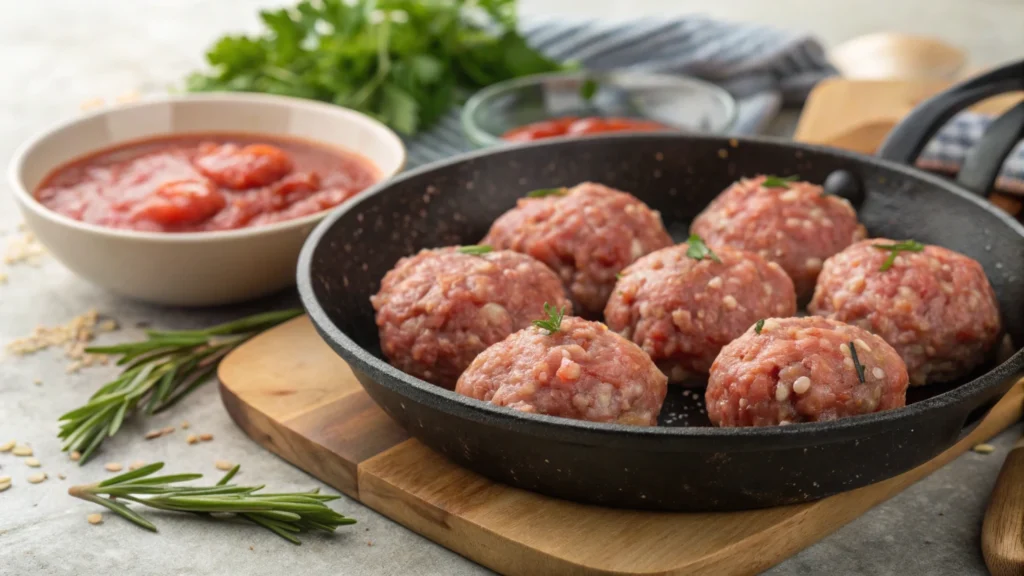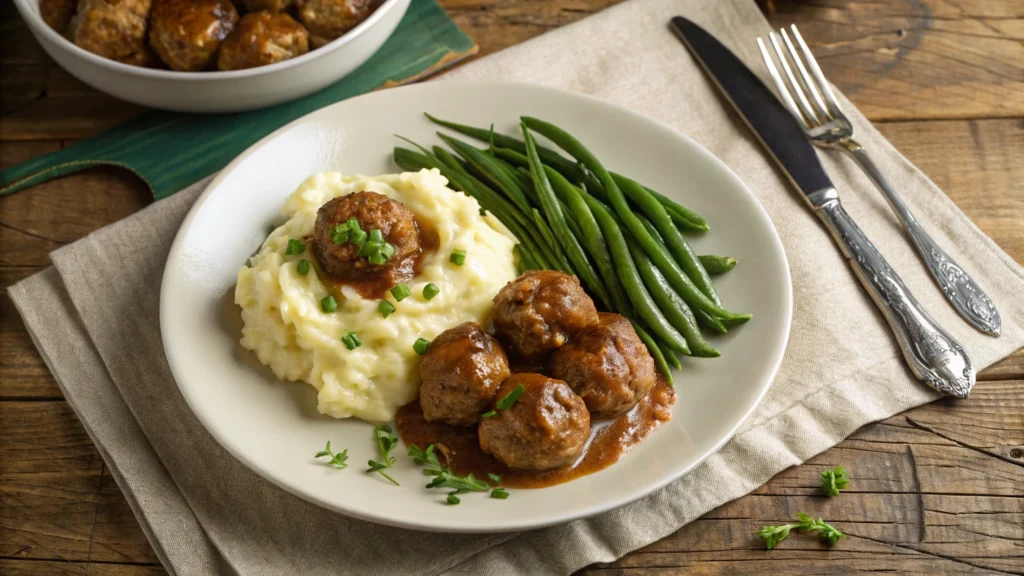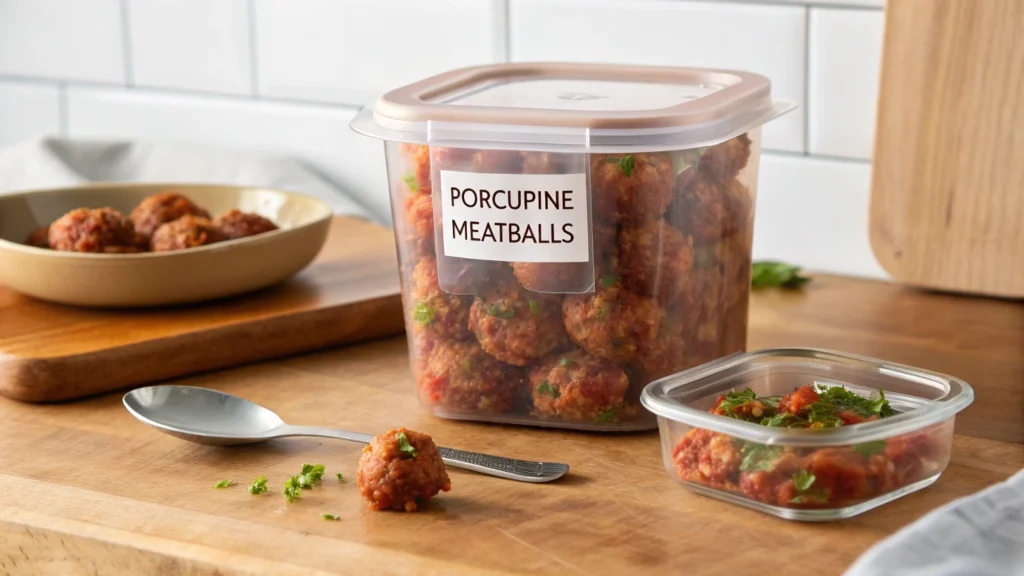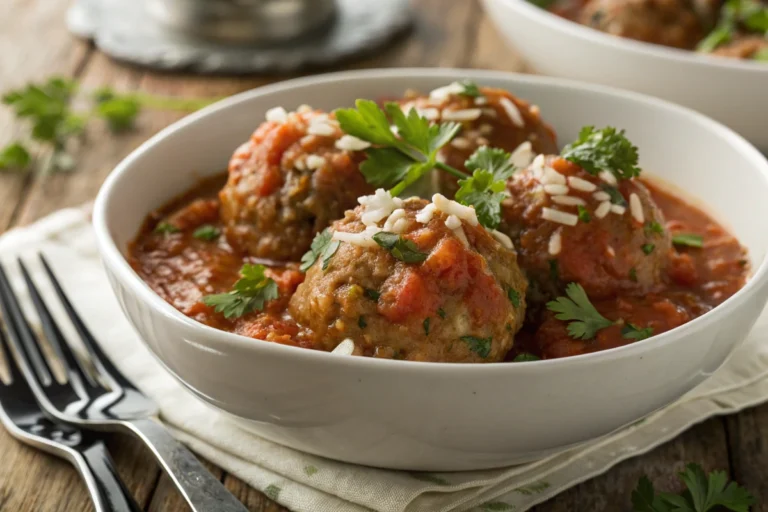Introduction
Porcupine meatballs are a nostalgic dish that has been passed down through generations. These meatballs, made with ground beef and rice, are simmered in a rich tomato sauce, creating a hearty, comforting meal. Their name comes from the way the rice pokes out of the meatballs, resembling porcupine quills.
This dish became popular during the Great Depression because it required simple, affordable ingredients. Today, porcupine meatballs remain a beloved recipe, cherished for their easy preparation and delicious taste. Whether you’re making them for a family dinner or meal prep, this guide will help you perfect them.
Table of Contents
Introduction to Porcupine Meatballs
The Origin of Porcupine Meatballs
Porcupine meatballs trace their roots back to the early 20th century. During the Great Depression, families needed to stretch their ingredients as much as possible, and rice was a perfect filler. By combining ground meat with rice and cooking it in tomato sauce, families created an affordable yet satisfying meal.
Why Are They Called Porcupine Meatballs?
The dish gets its name from the appearance of the cooked meatballs. As the meatballs simmer, the rice grains partially poke out, resembling porcupine quills. This unique look makes them stand out from traditional meatballs and adds a fun visual appeal to the dish.
Why This Recipe Is So Popular
Porcupine meatballs have remained popular for several reasons:
- Easy to Make: Requires minimal ingredients and simple cooking techniques.
- Budget-Friendly: Uses inexpensive pantry staples like ground beef, rice, and tomato sauce.
- Comforting and Delicious: The combination of juicy meatballs and flavorful sauce makes it a satisfying meal.
- Versatile: Can be served with various side dishes like mashed potatoes, pasta, or vegetables.
Now that we understand the history and appeal of porcupine meatballs, let’s explore the essential ingredients needed to make this classic dish.
Ingredients Needed for Porcupine Meatballs
Before you start cooking, it’s important to gather the right ingredients. The beauty of porcupine meatballs lies in their simplicity—just a few pantry staples come together to create a delicious dish.
Essential Ingredients for the Meatballs
To make classic porcupine meatballs, you’ll need the following:
- Ground beef (80/20 blend for the best balance of flavor and tenderness)
- Uncooked long-grain white rice (absorbs liquid and softens while cooking)
- Onion (finely chopped for added flavor)
- Egg (helps bind the mixture together)
- Garlic powder (adds depth to the meatballs)
- Salt and black pepper (seasoning for taste)
- Worcestershire sauce (optional, but enhances the umami flavor)
Choosing the Right Ground Meat
While traditional porcupine meatballs use ground beef, you can substitute other meats:
- Ground turkey – A leaner option that’s still flavorful.
- Ground pork – Adds a slightly sweeter taste and extra juiciness.
- Ground chicken – A lighter alternative with a more delicate flavor.
Types of Rice That Work Best
- Long-grain white rice – The most commonly used because it stays firm.
- Basmati rice – Adds a fragrant aroma but requires slightly more cooking time.
- Brown rice – A healthier choice, but it may need pre-cooking since it takes longer to soften.
Best Sauces for Cooking Porcupine Meatballs
The sauce is what makes porcupine meatballs extra flavorful. Here are some popular options:
- Tomato sauce – The classic choice for a rich, tangy taste.
- Tomato soup – Adds a slightly sweeter, creamier texture.
- Marinara sauce – Great for an Italian twist.
- Beef broth-based sauce – For a more savory, non-tomato alternative.
With your ingredients ready, it’s time to dive into the step-by-step cooking process.
Step-by-Step Guide to Making Porcupine Meatballs
Now that you have all the ingredients, it’s time to start cooking. Porcupine meatballs are simple to prepare and can be cooked using different methods, including stovetop, oven, or slow cooker.

Searing porcupine meatballs before simmering in sauce enhances flavor
Preparing the Meat Mixture
- In a large bowl, combine the ingredients:
- 1 lb ground beef
- ½ cup uncooked long-grain white rice
- 1 small onion, finely chopped
- 1 egg
- 1 teaspoon garlic powder
- ½ teaspoon salt
- ¼ teaspoon black pepper
- 1 tablespoon Worcestershire sauce (optional)
- Mix thoroughly until all ingredients are well combined. Be careful not to overmix, as this can make the meatballs tough.
Forming the Perfect Meatballs
- Shape the mixture into 1 to 1.5-inch balls. You can use a cookie scoop or roll them by hand.
- Ensure the rice is evenly distributed so the meatballs cook uniformly.
- Place them on a plate or tray while you prepare the sauce.
Cooking Methods: Stovetop vs. Oven vs. Slow Cooker
Stovetop Method (Traditional & Fastest Way)
- Heat 1 tablespoon of oil in a large skillet over medium heat.
- Brown the meatballs on all sides for about 5 minutes.
- Add 2 cups of tomato sauce (or your preferred sauce) and ½ cup of water or beef broth.
- Cover and simmer for 30–35 minutes until the rice is tender. Stir occasionally.
Oven Method (Hands-Off Cooking)
- Preheat your oven to 375°F (190°C).
- Place the meatballs in a baking dish.
- Pour tomato sauce over the top and add ½ cup of water or beef broth.
- Cover with foil and bake for 45–50 minutes. Remove the foil in the last 10 minutes to allow slight browning.
Slow Cooker Method (Best for Meal Prep)
- Place meatballs in the slow cooker.
- Pour in 2 cups of sauce and ½ cup of water or beef broth.
- Cook on low for 6–7 hours or high for 3–4 hours until fully cooked.
Now that you know how to cook porcupine meatballs, let’s discuss why they sometimes fall apart and how to prevent that.
Why Do Porcupine Meatballs Fall Apart? Troubleshooting Tips
One of the most common problems people face when making porcupine meatballs is that they fall apart during cooking. This can be frustrating, but with the right techniques, you can prevent it from happening.
Common Mistakes That Cause Meatballs to Crumble
- Not Enough Binding Ingredients – If there’s not enough egg or the mixture is too dry, the meatballs won’t hold together.
- Overmixing the Meat – Mixing too much can make the meatballs tough and crumbly.
- Using the Wrong Type of Rice – Instant or pre-cooked rice can make the mixture too soft, leading to breakage.
- Skipping the Browning Step – If cooking on the stovetop, searing the meatballs before adding sauce helps them hold their shape.
- Too Much Liquid – Cooking them in too much sauce without a proper balance can cause them to break apart.
How to Properly Bind the Meat and Rice
- Use an egg – It acts as a natural binder and keeps everything together.
- Add breadcrumbs (if needed) – If the mixture seems too wet, a tablespoon of breadcrumbs can help absorb excess moisture.
- Chill the meatballs before cooking – Letting them rest in the fridge for 20–30 minutes before cooking helps them firm up.
Cooking Techniques to Keep Meatballs Intact
- Brown them first – A quick sear in a hot pan before simmering in sauce adds structure.
- Don’t stir too often – Gently turn them once or twice while cooking instead of constant stirring.
- Use the right heat level – Cooking on medium-low heat ensures the rice inside has time to expand without breaking the meatball apart.
By following these tips, you can make perfectly firm and tender porcupine meatballs every time. Now, let’s talk about the flavor and texture of porcupine meatballs and what makes them so tasty.
The Taste of Porcupine Meatballs – What to Expect
Porcupine meatballs are not just visually unique—they also have a distinct taste and texture that make them a beloved comfort food. If you’ve never tried them before, here’s what you can expect in terms of flavor, texture, and how different ingredients influence the overall taste.
Flavor Profile: Meaty, Savory, and Comforting
- Rich and hearty: The combination of ground beef, rice, and tomato sauce creates a deep, savory flavor.
- Mild sweetness: If using tomato soup instead of sauce, it adds a slightly sweet and creamy undertone.
- Umami depth: Worcestershire sauce, garlic, and onions enhance the meatiness of the dish.
- Customizable spice level: You can keep the seasoning mild or add a bit of heat with crushed red pepper or cayenne.
How the Rice Changes the Texture
- Unlike traditional meatballs, porcupine meatballs have a softer, more tender texture due to the rice.
- As the rice cooks inside the meatballs, it absorbs moisture, making them juicy and slightly chewy in a satisfying way.
- The rice also creates tiny pockets of air inside the meatballs, keeping them light and fluffy instead of dense.
How Different Seasonings Enhance the Dish
- Garlic & Onion: Adds a deep, savory flavor base.
- Paprika & Cumin: Give a warm, slightly smoky taste.
- Italian Herbs (Basil, Oregano, Thyme): Perfect if you want an Italian-style version.
- Soy Sauce or Worcestershire Sauce: Enhances umami and adds a richer taste.
Porcupine meatballs are a fantastic dish on their own, but pairing them with the right side dishes can elevate the meal. Let’s explore some of the best side dishes to serve with them next.
Best Side Dishes to Serve with Porcupine Meatballs
Porcupine meatballs are hearty and flavorful, making them a perfect main dish. To complete your meal, pairing them with the right side dish is essential. Whether you’re looking for a classic, healthy, or creative option, here are some of the best sides to serve with porcupine meatballs.

Porcupine meatballs served with creamy mashed potatoes and green beans
Classic Pairings: Mashed Potatoes, Pasta, or Rice
These traditional sides complement the flavors and textures of porcupine meatballs:
- Mashed potatoes – The creamy texture balances the tanginess of the tomato sauce.
- Buttered noodles – Egg noodles or spaghetti absorb the sauce beautifully.
- Steamed rice – Perfect for soaking up extra sauce if you want a double rice dish.
- Garlic bread – A crispy, buttery option that pairs well with the savory flavors.
Looking for a crispy side dish to complement your porcupine meatballs? Check out this ultimate guide to making crispy hash browns for the perfect pairing!
Healthy Alternatives: Roasted Vegetables or Salads
For a lighter, more balanced meal, consider these healthy sides:
- Roasted broccoli or asparagus – Adds a fresh, slightly crispy contrast.
- Steamed green beans – A simple, nutritious side that complements the dish.
- Caesar salad – A crunchy, tangy option that cuts through the richness of the meatballs.
- Quinoa or cauliflower rice – Great low-carb options for a healthier twist.
Creative Serving Ideas for a Unique Meal
If you want to think outside the box, try these fun serving ideas:
- Meatball subs – Place porcupine meatballs in a toasted hoagie roll with melted cheese.
- Stuffed bell peppers – Serve meatballs inside roasted peppers for a colorful presentation.
- Zucchini noodles – A keto-friendly and fresh alternative to pasta.
- Polenta – A creamy, cheesy base that complements the meatballs beautifully.
Choosing the right side dish depends on your taste preferences and dietary needs. Now that you know how to serve porcupine meatballs, let’s explore how to store and reheat them properly.
Storing and Reheating Porcupine Meatballs
Porcupine meatballs make excellent leftovers, and with proper storage, they can last for days or even months. Whether you want to refrigerate, freeze, or reheat them without losing flavor, here’s how to do it right.

Properly storing porcupine meatballs keeps them fresh for later
How to Store Leftover Meatballs in the Fridge
- Allow meatballs to cool to room temperature before storing.
- Transfer to an airtight container with a lid to prevent drying out.
- Refrigerate for up to 3 days for the best freshness.
- If storing in sauce, ensure the meatballs are fully covered to maintain moisture.
Freezing Porcupine Meatballs for Later Use
If you want to keep them longer, freezing is a great option.
- Freeze uncooked meatballs on a baking sheet first, then transfer to a freezer-safe bag. This prevents them from sticking together.
- For cooked meatballs, place them in a container with sauce and freeze.
- Label with the date to keep track of freshness.
- Freeze for up to 3 months for the best quality.
Best Ways to Reheat Without Losing Flavor
Stovetop Method (Best for Keeping Moisture)
- Place meatballs and sauce in a skillet.
- Heat over medium-low heat for 10–15 minutes, stirring occasionally.
Oven Method (Best for Large Batches)
- Preheat oven to 350°F (175°C).
- Place meatballs in an oven-safe dish, cover with foil, and bake for 15–20 minutes.
Microwave Method (Fastest but May Dry Out)
- Place meatballs in a microwave-safe dish.
- Cover with a damp paper towel and heat in 30-second intervals until warm.
Proper storage and reheating will keep your porcupine meatballs tasting just as good as when they were first made. Now, let’s talk about how you can customize this dish to suit different dietary needs and flavor preferences.
Variations and Customizations for Porcupine Meatballs
Porcupine meatballs are incredibly versatile, allowing you to tweak the ingredients and flavors to fit your dietary needs and taste preferences. Whether you’re looking for a healthier option, a new flavor twist, or a dietary-friendly version, here are some great ways to customize this classic dish.
Making It with Different Meats: Turkey, Chicken, or Pork
While traditional porcupine meatballs use ground beef, you can switch it up with other meats:
- Ground turkey – A leaner option that still provides a rich flavor.
- Ground chicken – A lighter, slightly milder alternative.
- Ground pork – Adds a juicy, slightly sweeter taste to the meatballs.
- Ground lamb – For a bolder, more robust flavor.
💡 Tip: If using lean meats like turkey or chicken, add a little olive oil or an extra egg to keep the meatballs from drying out.
Adding More Flavor with Spices and Herbs
Want to spice things up? Try these seasoning variations:
- Italian-style – Add basil, oregano, thyme, and Parmesan cheese.
- Mexican-style – Use cumin, chili powder, and diced green chilies.
- Asian-inspired – Add ginger, soy sauce, and sesame oil.
- Spicy kick – Mix in red pepper flakes, smoked paprika, or cayenne pepper.
Gluten-Free and Keto-Friendly Adjustments
For those following a special diet, here are simple swaps:
- Gluten-free: Replace Worcestershire sauce with coconut aminos and use a gluten-free tomato sauce.
- Keto-friendly: Swap the rice for riced cauliflower or almond flour as a binder.
- Low-carb: Reduce the tomato sauce and serve with zucchini noodles instead of pasta or rice.
With these variations, you can make porcupine meatballs in countless ways to suit your preferences. Now, let’s answer some of the most frequently asked questions about porcupine meatballs.
If you love experimenting with flavors, why not try a sweet and spicy twist? This Honey Chilli Chicken recipe shows how a balance of flavors can transform a dish!
FAQs About Porcupine Meatballs
Here are answers to some of the most common questions people have about porcupine meatballs.
What are porcupine meatballs made of?
Porcupine meatballs are made with ground beef, uncooked rice, onion, garlic, egg, and seasonings, all mixed together and shaped into meatballs. They are then simmered in a tomato-based sauce until fully cooked. The rice inside expands as it cooks, creating a “porcupine” effect.
Why do my porcupine meatballs fall apart?
There are a few reasons why porcupine meatballs may fall apart:
- Not enough binding ingredients – Ensure you use an egg to help hold them together.
- Overmixing the meat – Too much handling can make them crumbly.
- Too much moisture – If the mixture is too wet, add a tablespoon of breadcrumbs to help bind it.
- Skipping the browning step – Searing the meatballs before simmering them in sauce helps maintain their structure.
Is porcupine meat tasty?
Porcupine meatballs do not actually contain porcupine meat! They are made with beef (or other ground meats). However, if you were wondering about real porcupine meat, it is said to be mild, slightly gamey, and similar to rabbit or dark meat poultry.
What is a good side dish to serve with porcupine meatballs?
Some of the best side dishes to serve with porcupine meatballs include:
- Mashed potatoes
- Butter noodles or spaghetti
- Steamed rice
- Roasted vegetables (broccoli, green beans, or carrots)
- Garlic bread or dinner rolls
- Caesar salad or a fresh green salad
Conclusion
Porcupine meatballs are a timeless comfort food that combines the heartiness of ground beef with the unique texture of rice. Their simplicity, affordability, and versatility make them a staple for families everywhere. Whether you’re cooking them on the stovetop, in the oven, or in a slow cooker, this dish is guaranteed to be a crowd-pleaser.
Now that you have all the tips, tricks, and variations, it’s time to try making your own porcupine meatballs at home!
Print
Porcupine Meatballs
Porcupine Meatballs are a classic comfort food dish featuring tender, juicy meatballs mixed with uncooked rice, giving them their signature “spiky” look. Simmered in a rich tomato sauce, these meatballs are a hearty, flavorful meal that’s perfect for family dinners. They’re easy to make and pair wonderfully with mashed potatoes or a side of vegetables.
- Total Time: 1 hour
- Yield: About 12–15 meatballs 1x
Ingredients
For the Meatballs:
- 1 lb ground beef (85% lean)
- ½ cup uncooked long-grain white rice
- ¼ cup onion, finely chopped
- 1 clove garlic, minced
- ½ teaspoon salt
- ½ teaspoon black pepper
- ½ teaspoon dried oregano
- 1 egg, lightly beaten
- 2 tablespoons milk
For the Sauce:
- 1 can (15 oz) tomato sauce
- 1 can (14.5 oz) diced tomatoes, undrained
- ½ cup water
- 1 teaspoon Worcestershire sauce
- ½ teaspoon salt
- ¼ teaspoon black pepper
- ½ teaspoon dried basil (optional)
Instructions
- Prepare the Meatballs: In a large mixing bowl, combine the ground beef, uncooked rice, chopped onion, garlic, salt, black pepper, oregano, egg, and milk. Mix well until all ingredients are evenly distributed.
- Shape the mixture into approximately 1½-inch meatballs, making about 12-15 meatballs.
- Prepare the Sauce: In a large skillet or deep pan, mix the tomato sauce, diced tomatoes, water, Worcestershire sauce, salt, pepper, and basil. Stir to combine.
- Place the meatballs in the skillet, making sure they are submerged in the sauce.
- Cover and simmer on low heat for about 45 minutes, stirring occasionally to ensure even cooking.
- Check for doneness by cutting one meatball in half—rice should be tender, and meat should be fully cooked through.
- Serve hot, garnished with fresh parsley if desired. Enjoy with mashed potatoes, pasta, or a side of vegetables.
Notes
- For extra flavor, add a pinch of red pepper flakes to the sauce.
- You can use brown rice instead of white rice, but it may take longer to cook.
- Leftovers store well in an airtight container in the fridge for up to 3 days or can be frozen for up to 3 months.
- Prep Time: 15 minutes
- Cook Time: 45 minutes
- Category: Dinner
- Cuisine: American
Nutrition
- Calories: ~320
- Fat: ~15g
- Carbohydrates: ~30g
- Protein: ~20g

